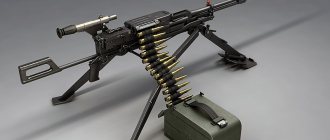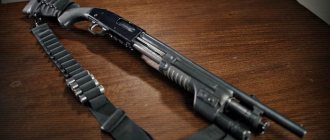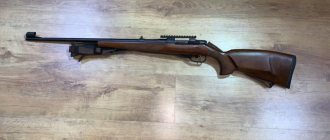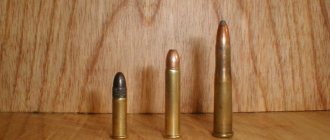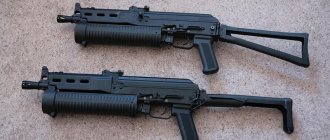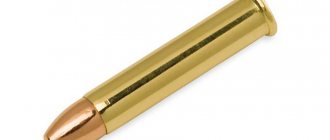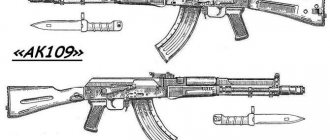Smoothbore weapons and their calibers
The correct choice of weapons and ammunition plays a key role during hunting. Russian hunters most often use smooth-bore shotguns, which have a smooth inside bore.
Smoothbore weapons appeared in 1498 in Germany. It is considered universal for hunting and self-defense. In Russia, such guns began to be produced in the 16th century. Our product received its official name - rifle.
Caliber designations
The caliber of the weapon must be indicated on its body. Also sometimes information about the dimensions of the cartridge is placed on the cartridge case.
In those countries where the English system of measures is used, the caliber of weapons and ammunition is indicated in inches. Typically, it is written in both hundredths and thousandths of an inch. In our country, until 1917, it was customary to measure caliber in lines. One line was equal to 0.1 inches or 0.254 centimeters. After the formation of the USSR, the calibers of weapons and cartridges began to be measured in millimeters.
The first digit indicated the diameter of the bore, and after the multiplication sign, the second digit, the length of the ammunition casing, was also noted. The last characteristic relates specifically to the cartridge, so even with the same caliber it may not fit the weapon. In Western European countries, the USA, Canada and other countries that are part of the NATO bloc, such markings are used only for army weapons.
For civilian ammunition in foreign countries, other designations apply, where the name of the manufacturer or the cartridge standard is assigned to the caliber. For example, 220 Russian or 38 Super.
Device
The Colt 1911 is built according to the classic design for 45-caliber self-loading pistols - a short-stroke barrel and a semi-ring locking bolt
Pistol design
Colt M1911 consists of 53 parts. The main ones, accessible to the user, are the bolt casing, the barrel with the hinge link, the fastening sleeve, the spring stop, the bolt spring with the guide pin, the barrel delay lever, which serves as a barrel lock, the frame, the trigger mechanism and the magazine.
The trigger mechanism is single action, hammer type, with an open trigger. A cylindrical mainspring of a twisted shape is located immediately behind the magazine well, in the rear of the handle. The trigger and mainspring are connected by a trigger rod. The pistol slide contains a spring-loaded inertia-type firing pin.
The trigger mechanism includes: a trigger rod with a sear attached to it, a trigger connected to the trigger rod and moving forward (the so-called classic “trigger” trigger), a trigger spring and a vertically moving disconnector.
When fired, the bolt moves back, the disconnector moves down the handle, disconnecting the sear and the trigger rod. The integrity of the structure is restored by releasing the trigger, that is, by removing the finger from the hook. Also, the disconnector opens the mechanism before the bolt returns to its original position, eliminating the possibility of even an accidental shot if the barrel is not locked.
The design of the safety is noteworthy - it is not located on the bolt housing, as is common in many pistols, but on the frame, which allows you to intuitively switch the trigger lock, spending less time on the shot.
Principle of operation
The Colt M1911 uses a short-stroke reloading system. The length of the barrel stroke is approximately 8-10 millimeters, then the barrel is held by the barrel delay lever, and the bolt continues to move backward by inertia, extracting the cartridge case from the chamber with the extractor tooth and throwing it out the extractor window. After reaching maximum spring compression, the bolt housing begins to move forward, driving the cartridge from the magazine into the chamber, locking the bolt and returning the barrel to its place.
Thus, the possibility of the cartridge sticking into the chamber cut is eliminated, due to the location of the cartridge and the barrel on the same line.
Ammunition for Colt M1911
Initially, the pistol was developed for a standard 45 caliber cartridge, later called .45 ACP (cartridge for the Colt 45 caliber automatic pistol). This is a classic ammunition with a wafer brass case and a bullet weight of 14.9 grams.
Subsequently, the range of cartridges acceptable for use in the Colt M1911 expanded:
.45 ACP is the standard cartridge for firing against manpower and unarmored vehicles. Brass sleeve, a spherical-cylindrical bullet, with a lead alloy core and a brass or steel, copper-plated shell.
.45 M26, Tracer - a tracer bullet, in some cases it can be used as a signal or incendiary ammunition. A cartridge with a standard brass sleeve, the bullet itself is three-component, consisting of a cup with a tracer mixture, a core made of a lead alloy with antimony and a copper-plated steel or brass shell.
The .45 Ball Match is a competition shooting cartridge. It is distinguished by its production with high precision; even the slightest deviations from established standards are not allowed. Brass sleeve, sleeve marked NM or Match.
.45 Wad Cutter is a sighting cartridge, also used to improve shooting accuracy. It is distinguished by a non-standard bullet shape in the form of a truncated cone. This bullet shape allows it to pass through a paper target, leaving straight holes.
.45 M1, High Pressure Test - a special high-pressure cartridge used only for testing weapons at the factory or after repair work. The sleeve has a shiny nickel plated finish.
The .45 M9, Blank, is a blank cartridge used in the film industry, as well as historical installations and intuitive fire training. Due to the nature of the ammunition, it is only allowed to be used in personal small arms of the appropriate caliber.
.45 M1921, Dummy - a dummy cartridge, intended only for training personnel in weapon equipment. It has perforation of the case walls, does not have a powder charge and a primer.
Classification of calibers
All cartridge calibers have their own classification. It looks like this:
- Category 1: small-caliber samples, the diameter of which does not exceed 6.5 millimeters.
- Category 2: weapons and ammunition of normal caliber, the diameter of which is in the range from 6.5 to 9 millimeters.
- Category 3: large-caliber weapons and ammunition for them. The diameter varies from 9 to 20 millimeters. The article contains a table with caliber .45 (in mm - from 11.26 to 11.35). The cartridge belongs specifically to this category.
- Category 4: artillery shells and cannons. The diameter exceeds 23 millimeters.
Links[edit]
- Mike Searson (2016-09-30). "45 Colt vs. 45 Long Colt - 45 Debate over Nothing". ammoland.com
. Archived from the original on 2016-10-01. Retrieved September 4, 2017. - Shooter Bible
(one hundred and seventh ed.). New York: Skyhorse Publishing Inc., 2015. ISBN. 978-1-63450-588-8. - Shideler, Dan (10 May 2011). Official Guns Digest on guns and prices
(2011 edition). ISBN 978-1440214356. - Taffin, John (2005). Single action sixguns
. Krause Publications. pp. 39–41. ISBN 978-0-87349-953-8. - Barnes, Frank S. (1997) [1965]. McPherson, M. L. (ed.). Cartridges of the World (8th ed.). DBI Books. pp. 270, 275. ISBN 0-87349-178-5.
- Hackley; and others. A History of Modern United States Small Arms Ammunition
.
1
. ISBN 1577470338. - Taffin, John (1 August 2010). "Half a Century of Hexes: Really Big Barrels". Guns Magazine
.
FMG. 8
(41). ISSN 1044-6257. Retrieved July 25, 2015. - Taffin, John (July 2001). "Custom loading .45 Colt". Guns
. Archived from the original on August 26, 2007. Retrieved February 14, 2011. - ^ ab Venturino, Mike (1998). "Lead". Popular Mechanics
.
Jay McGill. 175
(4):76–79. - US Army Ordnance Department (1917). Description of the Colt Model 1909 Double Action Revolver, .45 Caliber, with Operating Rules, Trajectory Memoranda, and Ammunition Descriptions. Washington: US Government Printing Office. Page 11 and plate V.
- ^ab Cartridges of the World
(14th ed.). Iola, WI: Krause Publishing. 2014. ISBN. 978-1-4402-4265-6. - Taffin, John (2010). "Big and Heavy". American pistol
. - ^ abc Reloading Guide No. 10
. Lewiston, ID: Speer - Omark Industries. 1979 - Ahern, Jerry (2010). Gun Digest Buyer's Guide to Concealed Carry Handguns
. F&W Media. pp. 207–208. ISBN 978-1-4402-1383-0. - Taffin, John (1997). Large caliber Sixguns
. Krause Publications. pp. 33–37. ISBN 978-0-87341-502-6. - Barnes, Frank S.; Skinner, Stan (20 October 2009). Cartridges of the World, 12th Edition: A Complete Illustrated Guide to Over 1,500 Cartridges
. Krause Publications. p. 568. ISBN 978-0-89689-936-0.
Popular calibers
Today, civilians and military personnel are presented with numerous types of small arms and ammunition of various sizes, including the .45 caliber indicated in the table (in mm - from 11.26 to 11.35). Such cartridges are used in both civilian and military weapons. To understand what main projectiles are used in the modern world, they need to be presented in the form of a table of cartridge calibers. It is discussed below.
| Russian designation of calibers in millimeters. | Designation in inches. | The internal diameter of the weapon's barrel is in millimeters. | Weapons of this caliber. |
| 5,6 | .22 | from 5.42 to 5.6 | MTs-3 pistol, TOZ-12 rifle, Ruger revolver. |
| 9 | .35 | from 8.7 to 9.25 | Beretta, Glock and GSh-18. |
| 11,43×23 | .45 | 11,51 | Colt Double Eagle, Thompson and De Lisle carbine. |
| 6,8×43 | .223 Remington | 7,04. | AR-15, CAR-15, INSAS, Vektor R4 and AK102. |
| 6,2×52 | .243 Winchester | 6,2. | Winchester model 70, Remington Model 700. |
| 7.62x63 | .30-06 Springfield | 7,85 | Browning M1919, M1 Garand, Johnson machine gun. |
Small caliber cartridge
So, we looked at the table of weapon calibers. The most popular rifled civilian weapon among novice hunters is .22 LR or 5.6 millimeters. It is used for shooting small animals, such as fur-bearing wild animals and rodents. This ammunition is also widely used in sports.
5.6mm cartridges and weapons were first demonstrated by the J. Stevens Arm & Tool Company in the late 19th century. They were originally intended for indoor shooting at paper targets. It is worth noting that the first 5.6 mm cartridge was a piston, which was placed in a copper cup. Small shot also fell there. Subsequently, various enterprises produced different variations of the cartridge with a bullet with a diameter of 5.6 millimeters. The length of the sleeve changed, as well as the filling options for the projectile for throwing. Today there are several types of this ammunition left:
- .22 Winchester Magnum Rimfire.
- .22 Short.
- .22 Long.
- .22 Long Rifle.
The last type is the most popular. It is equipped with a bullet weighing 2.6 grams. The initial speed of the projectile reaches 410 meters per second. Muzzle energy is about 190 J. The maximum range of guaranteed target destruction is 150 meters.
The popularity of the .22 LR cartridge is explained by its high accuracy, quiet pop when fired, minimal recoil and low cost. The disadvantages include the following factors:
- lack of stopping effect;
- low projectile power.
History of creation
At the beginning of the 20th century, the American army faced the urgent question of replacing standard 38-caliber revolvers with something more powerful. The indirect impetus for this decision was the American-Philippine War of 1899. The stopping power of a .38 caliber bullet was not sufficient to instantly kill an enemy, and a dying enemy could hit a US soldier. Also, at the moment, revolvers had insufficient rate of fire and high-speed shooting accuracy.
In 1900, 1902 and 1905, designer John Moses Browning developed three versions of the pistols, but all were rejected due to the complexity of the design and subsequent maintenance. Finally, in 1911, the designer introduced an easy-to-use and maintain weapon that satisfied the selection committee and subsequently became the standard weapon of army and police officers, called the Colt Government M1911.
The weapon withstood serious tests - a series of one hundred shots at intervals of five minutes, after every thousand it was disassembled for cleaning, lubrication and critical inspection for damage. After firing six thousand shots, the pistol was fired with cartridges with specially deformed ammunition and cartridges with different masses of gunpowder. After this, the gun was immersed in various acids, immersed in mud and sand. At the end of all the tests, the selection committee highly appreciated the performance characteristics, reliability and ease of maintenance of the pistol.
In 1926, the first and largest modification of the pistol was made, called the Colt Government M1911A1 - in addition to modernizing the trigger mechanism, cuts were made on the pistol frame for a more comfortable grip, corrugation was added to the hammer and trigger, the disconnect button on the back of the handle was extended, and additional corrugation applied to the handle.
Cartridge 5.6 x 39
The table of all calibers shows a cartridge measuring 5.6 x 39 mm. This is a hunting ammunition for rifles that is of Soviet origin. You need to know that its length is 48.7 mm from the tip of the bullet to the bottom of the cartridge case.
It was created in 1955 by designer M. Blum to kill large and medium-sized animals. The caliber was 7.62 x 39 mm. It is interesting to note that this cartridge was only used for game hunting.
There are two options for manufacturing this ammunition:
- With a jacketed bullet. Weight - 2.8 grams. It is designed to kill fur-bearing animals.
- With a semi-sheathed bullet, the mass of which is 3.5 grams. The cartridge is used for shooting at wolves and roe deer.
The main advantages of the cartridge are low price and high initial speed. Among the shortcomings, many hunters note poor workmanship and rapid loss of bullet speed.
Performance characteristics of the Colt M1911
| Curb weight, kg | 1,22 |
| Total length of weapon, cm | 21.6 |
| Barrel length, cm | 12.7 |
| Number of barrel rifling | 6, left-hand cutting |
| Cartridge | .45 ACP |
| Trigger resistance, kg | 1.5 |
| Cartridges in the store, pcs. | 7 |
| Initial bullet speed, m/s | 260 |
| Aim | open, unregulated. |
| Combat rate of fire, rds/min | 14 |
The resource of the weapon is also impressive - the number of shots required for serious maintenance of the weapon is set at the factory to thirty thousand.
Popular pistol cartridge
The most popular pistol cartridge is the 9 mm Luger caliber ammunition, created in Germany in 1902. It was designed by Georg Luger to fire the Parabellum pistol. After 2 years it was accepted into service. The first versions were produced in the shape of a cone with a flat head. Later, a projectile with an ogive head appeared. The bullet had a steel jacket and a lead core. After 1917 it was modified; now it is varnished on the outside with tombac.
Cases for this caliber were produced from various metals: brass, steel, with or without copper plating. There are different types of bullets, including plastic ones. The 9 x 19 caliber pistol cartridge is a general purpose ammunition consisting of a shell containing a lead core.
History[edit]
Diagram of the US Army .45 Colt cartridge for the M1909 Army revolver with dimensions in inches.
The Colt .45 was a joint development of Colt's Patent Firearms Manufacturing Company of Hartford, Connecticut, and the Union Metallic Cartridge Company of Bridgeport, Connecticut. Colt began work on the revolver in 1871 and presented a model to the US Army in late 1872. The revolver was accepted for purchase in 1873.[4]
Cartridge with internal lubricant. The heel rebate bullet design of its predecessor, the .44 Colt (.452–.454 inch diameter bullet), was eliminated because it was an externally lubricated type that would pick up dirt and sand during handling. replaced the Remington Model 1871 single shot .50 caliber pistol and various cap and ball revolvers converted to use then-metallic cartridges. While the Colt remained popular, the Schofield Revolver Smith & Wesson M1875 Army revolver was approved as an alternative, creating logistical problems for the Army. The S&W revolver used the .45 S&W Schofield, a shorter cartridge that would also accept Colt, however S&W Schofield Army revolvers could not chamber the longer .45 Colt,[5] so in 1874 the Frankford Arsenal, then almost exclusive small arms ammunition supplier to the US Army, ceased production of the .45 Colt in favor of the .45 S&W. This solved the Army's ammunition logistics problems, but after production ceased there were still many longer Colt cartridges in circulation. Benet's .45 caliber revolver cartridges were subsequently replaced by "Model of 1882 Ball" cartridges for the Cal. .45 Revolver", which used an external Boxer primer and could be reloaded at the unit level. [6] The M1882 .45 caliber cartridge would be officially replaced by the .38 Long Colt cartridge in 1892, but was not produced until approximately 1896. In 1901–1902 she was again loaded by Frankford Arsenal for use in the Philippines.
In 1909, the .45 M1909 cartridge was released along with the .45 Colt New Service revolver. This cartridge has never been used commercially and is almost identical to the original .45 Colt cartridge, except that it has a larger diameter rim. The rim is large enough that it cannot be loaded in adjacent chambers in a Colt model with a rod ejector.
The Colt .45 remains popular due to renewed interest in cowboy shooting. Additionally, the cartridge saw a resurgence as a cartridge in firearms hunting and metallic silhouette shooting competitions beginning in the 1950s with the advent of stronger, heavier frame pistols. The cartridge's popularity has also increased with the increase in sales of handguns that can also fire a .410 caliber shotgun, such as the Taurus Judge and S&W Governor. The modern .45 Colt bullet has also changed and is now 0.451 inches in diameter for jacketed bullets and .452 for lead bullets. The Colt .45 became the basis for other cartridges such as the .454 Casull. [7]
.45 caliber cartridges
According to the information from the above table, .45 caliber (in mm 11.43) comes in several types. The most popular cartridges in this size are those referred to as the .45 Automatic Colt Pistole (ACP) and .45 Colt. The first option is called the grandfather of all American pistols. The cartridge was invented by John Moses Browning for the 1905 model pistol. After its commissioning, the device was immediately loved in the USA. It was used by the army and also by the police until 1985.
The .45 ACP has earned the love of many Americans thanks to its heavy 12.58 gram bullet and weak load. At low speed and low recoil, the bullet hits the target exactly. It has a strong stopping effect. The ammunition is still used by American police today.
The Colt M1911 pistol was created for this cartridge. Subsequently, American designers came up with the Thompson and M3 submachine guns, which also used a 0.45-inch bullet. Such weapons were actively used in the First World War.
Since the .45 ACP caliber has a low muzzle velocity, several types of silent subsonic rifles were invented for it - including those equipped with silencers - for hidden shooting. Such weapons are needed by intelligence services and special forces.
The British used the .45 ACP cartridge to fire Webley-Scott pistols. The .45 Colt revolver cartridge was invented in 1873. It was used when shooting from the Single Action Army revolver of the 1873 model. These weapons were supplied to horse artillery and cavalry. Despite the fact that .45 Colt ammunition has not been used in the army for more than 100 years, it is in demand in hunting and in civilian shooting ranges.
The cartridge has a lead bullet without a jacket. Its weight is 17.3 grams. The initial speed is about 260 m/s, and the muzzle energy is 570 J.
Colt M1911: the most famous American pistol in history
This pistol was created more than a century ago, it went through two world wars and a huge number of military conflicts on a smaller scale, while the weapon is still in service and is produced by a large number of companies around the world that produce its modern versions, as well as clones. The pistol is actively used by police officers, military personnel, sports shooters and ordinary citizens. Despite its venerable age for firearms, this pistol is in no hurry to leave the global arms market. All this has been said about the legendary creation of the gifted gunsmith designer John Moses Browning: his M1911 model pistol has become one of the symbols of the United States.
Surprisingly, the M1911 self-loading pistol, adopted by the American army in 1911, has become more popular today than the Colt revolver, which was destined to “equalize all people in rights.” This model, its modernized versions and clone pistols are still produced more than 100 years after its creation, and collectors and amateur shooters around the world are chasing rare copies of the famous pistol. An interesting fact is that the patent for this pistol was issued on February 14, 1911, on Valentine's Day, which, naturally, has nothing to do with its more than century-old fame.
In the American army, this pistol model was widely used from 1911 to 1985, after which it was removed from service. At the same time, the Colt M1911 self-loading pistol is still permitted for use. In our country, we became acquainted with this development of Browning already during the First World War. The officers bought some of the pistols at their own expense even before the war; During the war years, several thousand more of these pistols were purchased, but this time centrally. Then the pistols were supplied to representatives of the White movement; in total, until 1918, more than 13 thousand pistols of this model were sent to the Russian Empire. During the Civil War, this weapon was used by both whites and reds. During the Second World War, Colt M1911 pistols were used by officers of the Red Army, initially they were captured models, a legacy of the Civil War. But during the war, as part of the Lend-Lease program, the USSR received another 12,997 pistols of this type from the United States.
John Moses Browning
At the beginning of the 20th century, self-loading pistols became quite widespread in Europe. At the same time, the automation of most of them worked by locking the barrel bore with a free bolt; most often, low-power ammunition was used with the weapon. Against this background, after the end of the colonial war in the Philippines, the American military realized that the existing .38-caliber revolvers had insufficient, low power; the army needed 45-caliber weapons. At the same time, revolvers, although they had a number of positive qualities: a long service life, simplicity and smooth production, low cost, they were inferior to self-loading pistols in rate of fire and accuracy of rapid fire.
John Browning, who was in the process of creating a pistol chambered for the .38 caliber, learned about the military’s need for a new pistol. He quickly converted the pistol to a caliber of interest to the American military and showed them the first model. The .45APC (11.43 mm) cartridge was developed back in 1904 for the Colt Model 1905 pistol with the participation of Browning himself. The cartridge was distinguished by a high muzzle velocity and good energy performance. It is worth noting that John Moses Browning was a gunsmith from God; such people are really rare. Over the 71 years of his life, he designed 37 models of rifled and 18 models of smooth-bore weapons. He created rifles, machine guns and pistols with equal success, many of which became legendary developments in their field. His designs were repeatedly copied and were also imitated by gunsmiths in other countries.
The converted model of the pistol chambered for .45APC was well suited to the announced conditions of the tactical and technical specifications for the new army pistol: caliber of at least 11.43 mm, muzzle velocity of at least 243.8 m/s, bullet weight within 14.9- 15.2 g. The tests carried out only confirmed the advantages of the pistol model proposed by Browning.
M1911 pistol, released in 1914
Two companies took part in the competition to develop a new self-loading pistol for the American army: Colt and Savage. Testing of the pistols (both chambered in .45APC) began on November 10, 1910. Of these, it was planned to fire at least 6,000 shots; for weapons from the beginning of the last century, this was a very serious indicator. As a result, the gun turned out to be significantly more reliable - 11 delays versus 33 for its competitor. On March 15, 1911, after improvements carried out by the companies, pistol testing was resumed. And this time, during their course, the significant superiority of the pistol created by Browning was revealed; it was superior in strength and reliability of operation. According to the commission's conclusion, the pistol was superior to its competitor in strength, reliability, shooting accuracy and ease of disassembly. As a result, the Browning pistol was recommended for further testing by the troops. Already on March 29, 1911, a self-loading pistol designed by John Browning was finally adopted by the American army under the designation Colt M1911, also known as the Government Model. Since 1913, the pistol began to appear in the US Marine Corps and US Navy.
At first, the Colt M1911 pistol was produced at Colt factories, but they were soon joined by Springfield Armory, Remington-UMC, and North American Arms Co. During the First World War, pistols of this model were supplied to the armies of Great Britain, France and Russia, and then were used by the American army, which entered the war shortly before its end. World War I proved that the .45APC cartridge was the right choice. The powerful cartridge had a stopping effect at a distance of up to 100 meters. A heavy bullet fired from a Colt M1911 pistol stopped the enemy, making him unable to resist, even hitting his limbs. At the same time, weapons of smaller calibers were not as effective, since a wounded enemy soldier, as a rule, could return the shot. And the heavy Colt bullets simply knocked the enemy down or concussed him so much that he dropped his weapon. The M1911 pistol established itself as an easy-to-use firearm, and the box magazine located in the handle made it possible to reload the pistol almost instantly.
But the pistol also had its drawbacks, which included: significant weight, strong recoil, susceptibility of the pistol’s automatic system to contamination, and small magazine capacity. To be fair, it should be said that such shortcomings were also characteristic of other pistols during the First World War.
The experience of American soldiers in the First World War made it possible to make a number of minor changes to the design of the pistol: - the “tail” of the handle safety key was lengthened, the spoke of the hammer cocked when firing and the holding hand were better separated; — the mainspring stop has been changed, the rear part of the handle has acquired an arched shape; — the trigger protrudes less, the length of its stroke has been reduced; — inclined recesses for the index finger appeared in the frame behind the trigger; — the notch on the cheeks of the handle reaches the fastening screws.
An updated version of the pistol was put into service in 1926, the model was designated M1911A1. In its updated form, the pistol existed until the end of World War II. After the end of the world conflict, several modifications of popular weapons were released in the United States: Commander, Officer's, Double Eagle and a number of others. It is worth noting that these modifications of the self-loading pistol did not have any fundamental differences compared to the M1911A1 model.
Colt M1911 pistol design
The pistol consisted of 53 parts and three main parts: the barrel, the frame and the bolt casing. The pistol bolt moved along guides in the frame. The barrel was connected to the pistol frame using a swinging earring, which was located under the breech of the barrel and a transverse rod located in the frame.
The engagement of the pistol barrel with the bolt (locking the barrel) occurs using two semi-circular lugs (lugs) on the barrel and grooves located on the upper inner surface of the bolt in front of the window designed for extracting spent cartridges. After the shot, the barrel of the pistol, which is engaged with the bolt, moves backward. The earring rotates on the under-barrel axis and the rod in the frame, the breech of the pistol barrel is lowered. The pistol barrel lugs disengage with the bolt grooves. The barrel is then stopped by a rod in the frame, and the bolt continues its movement back, then ejects the cartridge case, cocks the pistol and compresses the return and mainsprings.
The swinging earring was located under the breech of the barrel. The return spring with a guide rod is located under the pistol barrel, the mainspring with guide rods is located in the pistol grip. Inserted into the frame of the Colt M1911 handle are: a plate-like three-arm trigger spring, a trigger rod, a trigger, as well as a handle safety, which can block the trigger, preventing it from breaking off the cock, until the handle is completely clasped in the shooter’s palm.
The trigger mechanism (trigger mechanism) of a single-action pistol, with an open trigger. The pistol uses a coiled cylindrical mainspring, which is located behind the magazine. The force of this spring is transmitted to the trigger through the rod. The firing pin is located at the rear of the bolt and was spring-loaded and recessed into the bolt to prevent premature firing. The trigger rod of the pistol moves longitudinally in the grooves of the frame. In order to prevent premature shots, a disconnector is located on the same axis with the sear at the rear of the pistol grip. When the bolt is rolled back until the barrel is locked, the disconnector with its stem comes out of the bolt recess, lowering down the rear part of the trigger rod, moving the rod away from the sear protrusion. When the shooter releases the trigger after firing, the disconnector rotates under the action of the plate trigger spring and brings the trigger rod under the sear, entering with its stem into the recess of the bolt.
There is a safety catch on the left side of the pistol frame. The direction for turning on the safety is the same as for the PM pistol. When the flag is raised, the Colt safety locks the bolt, sear, and prevents the hammer from moving forward. In this case, the trigger can be left cocked when the safety is on; this compensates for the insufficient efficiency of using small arms with a single-action trigger when the hammer is not cocked. When the hammer is cocked, the shooter can turn off the safety by lowering the flag.
With the safety switch off, the shooter can decock the hammer by holding it with his thumb and also pressing the trigger. At this point, the grip safety, which prevents the trigger rod from moving rearward, must be turned off by the grip of the pistol grip. After a soft release, the hammer will automatically engage the safety cock, which intercepts the hammer that has broken during cocking, thereby preventing contact of the hammer with the firing pin until the hammer is cocked. When the safety is engaged, the under-cocked hammer of the M1911 pistol stops and can be cocked. When the hammer is not cocked, the safety can be turned off by lowering the flag or cocking the hammer. The magazine release button, designed for 7 rounds, is located on the left side of the handle, at the base of the trigger guard.
The transverse rod in the pistol frame is also the axis of the bolt stop lever. When the magazine is exhausted, the tooth of the lever from below rests against the recess of the bolt, after which the bolt is held in the rear position. In order to release the shutter from the delay, you must press the lever down. If before this the shooter replaces the magazine with a loaded one, then the cartridge will go into the chamber and the pistol will be completely ready to fire a shot.
For more than 100 years since the appearance of the Colt M1911, he not only managed to take part in a huge number of wars, but also became the hero of numerous films, computer games and even cartoons. The pistol’s well-remembered profile, recess under the barrel, smooth grip cheeks and dimensions are familiar to many today. Currently, the pistol is not only used by law enforcement officers and the military, but also by civilians, occupying the niche of one of the most sought-after pistols for self-defense.
Tactical and technical characteristics of the M1911: Caliber - 11.43 mm. Cartridge - .45APC (11.43x23 mm). Length - 210 mm, height - 133 mm. Barrel length - 217 mm (Government model). Weight without cartridges - 1.1 kg. The initial bullet speed is 251 m/s. Magazine capacity - 7 rounds (+1 in the barrel).
Sources of information: https://huntsmanblog.ru/pistolet-colt-m1911 https://smallarms.ru/article?arms=colt_m1911 https://shkolazhizni.ru/culture/articles/42569 https://army-news. ru/2013/08/pistolet-colt-m1911-i-ego-modifikacii Materials from open sources
.223 Remington cartridge
Among cartridges of all calibers, the .223 Rem ammunition especially stands out. or 5.56 x 45 mm, which has been actively used in NATO countries since 1980. When creating a new ammunition, the designers decided to use the .222 Remington cartridge as a basis.
Rifle caliber .222 Rem. was needed for small rifles, but later it turned out that its power was not enough to defeat enemy personnel. Then a new type of ammunition appeared - .222 Remington Special. To avoid confusion, it was later renamed the .223 Rem. This rifle caliber was used to fire the famous AR-15 rifles. It is better known to the Russian-speaking public as M-16.
The advantage of this cartridge is the high destructive power of the projectile, and the main disadvantage is the low initial speed of the projectile being thrown.
Colt 1911 – American Veteran
Colt 1911 – American Veteran
Advantages and disadvantages
pros
High stopping power of the bullet. Veterans of various wars noted the pistol’s complete compliance with the OSS (one-shot stop) scheme - the enemy, even drugged, could not survive a hit from the pistol.
Soft trigger action. Despite its austere appearance, the pistol has a surprisingly soft trigger, which contributes to a more accurate shot.
The ergonomics of the weapon allows you to use the pistol for intuitive shooting. This is influenced by the location of the safety catch, a comfortable angle of inclination of the handle, and the optimal shape for a quick grip.
Simplicity and reliability of the design.
Minuses
Lack of standardization of production depending on the manufacturer. For example, different factories used different fuse models, which often caused confusion during maintenance.
Large dimensions and large weight.
Small magazine capacity.
.243 Winchester ammunition
In addition to the .45 caliber, the table shows the .243 Win cartridge in mm. The ammunition is especially popular among professional hunters of large animals. It is excellent at hitting targets such as antelope, wild boar or deer.
The cartridge was invented in 1955 by the American company Winchester for high-precision sports shooting. The ammunition was distinguished by its high initial velocity and mild recoil.
The ammunition was greatly loved by many Americans. Subsequently, it was widely used by shooters from Western Europe and Russia.
The advantages of such a cartridge are high speed and high power. The main disadvantage is the extremely high price compared to the prices set by competitors.
Cartridge .30-06 Sprg
The 7.62 x 63 mm caliber (.30-06 Springfield) is designed for rifle shooting. It was used extensively by American soldiers during World War I and World War II, as well as during the Korean conflict.
The ammunition was adopted for service in 1906 for firing from M1 Garand rifles.
It is worth noting that the advantages of the .30-06 Springfild cartridge were highly appreciated by Russian hunters, who used it against large and medium-sized wild animals. The ammunition - thanks to the large cartridge case and the large mass of gunpowder in it - is very powerful, not giving the target a single chance of salvation. Due to the fact that this type of American-made ammunition is produced in Russia, it has a relatively low cost.
Photo of the Colt Peacemaker revolver
Pneumatic revolver Colt Single Action Army (SAA) Peacemaker
Colt SAA revolver details:
cylinder with ratchet - drum with a ratchet base pin - drum axis base pin bushing - movable tube ejector tube - ejector case ejector with spring - ejector with a spring hammer with hand - trigger with a spoke (with a roller) main spring - mainspring cylinder locking bolt - drum stopper trigger - trigger trigger/bolt spring - trigger/bolt spring
Similar
AK-47 assault rifle cartridge caliber 7.62 mm.
Device. Rate of fire AK-74 assault rifle cartridge 5.45 mm caliber. Device. Rate of fire
Dragunov SVD sniper rifle caliber 7.62 mm. Device
AKS-74U assault rifle cartridge caliber 5.45 mm. Device. Weight
Mauser K96 pistol cartridge caliber 7.63 and 9 mm. Device
Pistol Walter PP / PPK cartridge caliber 7.65 and 9 mm. Device
Pistol Yarygin PYa Grach cartridge caliber 9 mm. Device
DShK machine gun cartridge caliber 12.7 mm. Device. Rate of fire
Luger pistol R.08 Parabellum cartridge caliber 9 mm. Device
Pistol PM cartridge caliber 9 mm. Rate of fire. Dimensions. Bullet speed. Sighting range
Self-loading shotgun Saiga-12 cartridge, caliber. Device
Maxim machine gun cartridge caliber 7.62 mm. Device. Weight
PPSh-41 Shpagina submachine gun cartridge caliber 7.62 mm
APS Stechkin pistol cartridge caliber 9 mm. Device
Nagan system revolver cartridge caliber 7.62 mm. Device
Kalashnikov PK machine gun and PKM cartridge caliber 7.62 mm. Device
Simonov carbine SKS-45 cartridge caliber 7.62 mm. Device
Rifles and carbines Mauser 98 caliber 7.92 mm. Device
PPS-42 and PPS-43 Sudaev submachine gun cartridge caliber 7.62 mm
Pistol Walter P38 cartridge caliber 9 mm. Device
MP-40 German submachine gun cartridge caliber 9 mm. Device
VSS Vintorez sniper rifle caliber 9 mm. Device
Submachine gun PP-91 Kedr cartridge 9 mm caliber. Device
Light machine gun RPK-74 cartridge caliber 5.45 mm. Device
Pistol Glock 17 cartridge caliber 9 mm. Device
Makarych, Izh-79-9T, MR-79-9TM, MP-80-13T traumatic pistol
AK-12 assault rifle cartridge caliber 5.45 mm. Device. Weight
Mosin rifles and carbines Three-line caliber 7.62 mm
PMM Makarov pistol modernized 12 rounds. Device
Revolver Colt Single Action Army (SAA) Peacemaker. Device
Machine gun PKP Pecheneg cartridge caliber 7.62 mm. Device
Sniper rifle VSSK Exhaust caliber 12.7 mm. Device
Beretta pistol 92 cartridge caliber 9 mm. Device
TT - Tokarev pistol cartridge caliber 7.62 mm. Device
Submachine gun PP-19 Bison cartridge caliber 9 and 7.62 mm. Device
Sniper rifle SV-98 caliber 7.62 mm. Device
Vladimirov KPV machine gun cartridge caliber 14.5 mm. Device
ASH-12 assault rifle cartridge caliber 12.7 mm. Device. Rate of fire
PSM pistol cartridge caliber 5.45 mm. Device
Pistol Colt M1911A1 cartridge caliber 45. Device
Smith-Wesson revolver Russian cartridge, caliber 10.67 mm. Device
Degtyarev DP-27 light machine gun, 7.62 mm caliber cartridge. Device
Shotgun Mossberg 500 Cartridge. Dimensions. Rate of fire. Sighting range
Thompson submachine gun cartridge caliber 11.43 mm. Device
Pistol USP Heckler und Koch cartridge, caliber. Device
Hunting carbine OSK-88 (SVT-40) caliber 7.62 mm. Device
AS Val silent automatic cartridge caliber 9 mm. Device
Submachine gun PP-19-01 Vityaz cartridge 9 mm caliber. Device
Machine gun Kord cartridge caliber 12.7 mm. Device. Weight. Sighting range
Osa - traumatic pistol cartridge, caliber. Device
AK-9 assault rifle cartridge caliber 9 mm. Device. Rate of fire
Degtyarev RPD light machine gun, 7.62 mm caliber cartridge. Device
Automatic OTs-14 Groza cartridge caliber 9 mm and 7.62 mm. Device
Czech pistol CZ-75 (modifications). Device
Browning pistol 1903 cartridge caliber 9 mm. Device
Sniper rifle OSV-96 caliber 12.7 mm. Device
FN P90 submachine gun cartridge caliber 5.7 mm. Device
Submachine gun OTs-02 Cypress cartridge caliber 9 mm. Device
Sniper rifle ASVK Kord caliber 12.7 mm. Device
Automatic AEK-971 Cartridge. Caliber. Device. Rate of fire
Steyr AUG assault rifle (A1, A2, A3) cartridge caliber 5.56 mm
AK series 100 assault rifles. Modifications. Device. Weight. Dimensions
Uzi submachine gun. Cartridge. Caliber. Rate of fire
Pistol SR1M Gyurza cartridge caliber 9 mm. Device
Pistol GSh-18 cartridge caliber 9 mm. Device
SVDK sniper rifle caliber 9.3 mm. Device
Automatic SR-3M Whirlwind cartridge caliber 9 mm. Device
Machine gun NSV-12.7 Utes cartridge, cal. Device. Weight
Kalashnikov RPK light machine gun cartridge caliber 7.62 mm. Device
Sniper rifle VSK-94 caliber 9 mm. Device
Vostok-1 (Jorge-3M) 9mm caliber traumatic pistol. Device
Degtyarev PPD submachine gun cartridge caliber 7.62 mm
English sniper rifle L96A1 cartridge, caliber
M1 Garand rifle cartridge caliber 7.62 mm. Device
Desert Eagle pistol. Device
Smith-Wesson revolver (modifications). Device
Automatic rifle HK G36 (E, K, C, KE) cartridge caliber 5.56 mm
Pistol P-96 cartridge caliber 9 mm. Device. Rate of fire
Pistol GP35 Browning High Power cartridge, caliber. Device
Assault rifle FN SCAR (L, H) cartridge caliber 5.56 and 7.62 mm
Revolver Lefoshe M1856 cartridge caliber 11 mm. Device
Submachine gun PP-90 cartridge caliber 9 mm. Device
AN-94 Abakan automatic Nikonov cartridge caliber 5.45 mm. Device
Submachine gun PP-2000 cartridge caliber 9 mm. Device
Mauser pistol HSc cartridge caliber 7.65 and 9 mm. Device
M16 automatic rifle cartridge caliber 5.56 mm. Device
Fedorov assault rifle cartridge caliber 6.5 mm. Device. Rate of fire
Pistol Baltiets cartridge caliber 7.62 mm. Device
Strizh pistol cartridge caliber 9 mm. Device. Weight. Sighting range
Browning pistol 1910 cartridge caliber 7.65 and 9 mm
Silent pistol PSS Vul cartridge caliber 7.62 mm. Device
Pistol SIG-Sauer P226 cartridge caliber 9 mm. Device
Pistol OTs-27 Berdysh cartridge caliber 7.62 mm and 9 mm. Device
AK-107 assault rifle cartridge caliber 5.45 mm. Device. Rate of fire
OTs-44 sniper rifle, caliber 12.7 mm. Device
German machine gun MG3 cartridge caliber 7.62 mm. Device
Self-loading shotgun Browning Auto-5 cartridge, caliber. Device
Submachine gun AEK-919K Kashtan cartridge caliber 9 mm. Device
PB pistol silent cartridge 9 mm caliber. Device
Pistol OTs-33 Pernach cartridge caliber 9 mm. Device
Hunting carbine KO-98 cartridge caliber 7.92 mm. Device
TK (Korovin pistol) caliber 6.35 mm. Device. Weight. Dimensions
Underwater assault rifle APS cartridge caliber 5.66 mm. Device
Pistol OTs-21 Malysh cartridge caliber 9 mm. Device
American M60 machine gun, 7.62 mm caliber cartridge. Device
MTs-116M sniper rifle, caliber 7.62 mm. Device
Automatic 9A-91 cartridge caliber 9 mm. Device. Rate of fire
Submachine gun PP-93 cartridge caliber 9 mm. Device
VAG-73 - Gerasimenko pistol. Device. Weight. Dimensions
Cordon-5 is a traumatic pistol. Device. Weight. Dimensions
Goryunov SG-43 heavy machine gun cartridge caliber 7.62 mm. Device
Webley revolver cartridge, caliber. Device. Dimensions. Weight
Machine gun AEK-999 Badger cartridge caliber 7.62 mm. Device
RP-46 machine gun, 7.62 mm caliber cartridge. Device. Rate of fire
Sniper rifle VS-8 cartridge caliber 8.6 mm. Device
Slostin machine gun cartridge caliber 7.62 mm and 14.5 mm. Device
Assault rifle Tavor TAR-21 cartridge caliber 5.56 and 5.45 mm
Submachine gun SR-2 Veresk cartridge caliber 9 mm. Device
Lancaster pistol cartridge caliber 12.1 mm. Device. Rate of fire
Submachine gun PP-90M1 cartridge caliber 9 mm. Device
Underwater pistol SPP-1M. Device. Weight. Dimensions
Traumatic pistol MP-461 Guard. Device. Weight. Dimensions
Lebel rifles and carbines are cartridgeed in 8 mm caliber. Device
Automatic A-91 cartridge caliber 7.62 mm. Device. Rate of fire
M14 automatic rifle cartridge caliber 7.62 mm. Device
Revolver Smith & Wesson Model 10 Military & Police
Automatic rifle FN FAL cartridge caliber 7.62 mm. Device
Submachine gun STEN MK 2. Device. Weight. Dimensions
Traumatic pistol IZH-78-9T Chain mail cartridge caliber 9 mm
Leader-M traumatic pistol 11.43×32T. Device. Weight. Dimensions
Ingram M10 and M11 submachine gun. Device. Weight. Dimensions
Pistol Steyr M9-A1 cartridge caliber 9 mm. Device. Weight
Pistol OTs-23 Dart cartridge caliber 5.45 mm. Device
Berthier rifles and carbines caliber 8 mm. Device
Automatic shotgun USAS-12 cartridge caliber 18.5 mm
Sniper rifle VS-121 caliber 7.62 mm. Device
Traumatic pistol MP-353 cartridge, caliber 11.43 mm
Tiss machine gun cartridge caliber 9 mm. Device. Rate of fire
Traumatic pistol MP-355 cartridge caliber 9 mm. Device
Automatic double-medium ADS cartridge caliber 5.45 mm. Device. Rate of fire
Traumatic pistol MP-81 cartridge caliber 9 mm. Device
Pistols Zastava 70 and 70(k), cartridge caliber 7.65 or 9 mm. Yugoslavia
Sniper rifle GALATZ (Galil) cartridge caliber 7.62 mm
Pistol MP-444 Bagheera cartridge caliber 9 mm. Device
Revolver Colt New Army / Navy. Device. Bullet speed. Sighting range
Type 64 is a Japanese automatic rifle. Device




